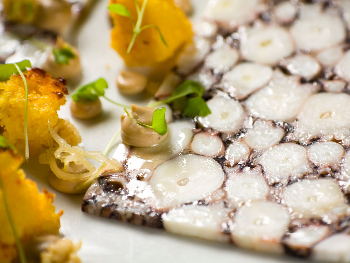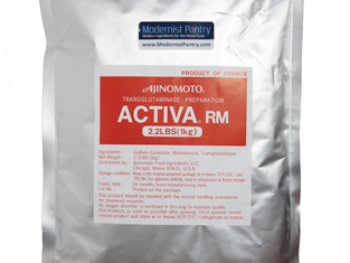
What is it?
Transglutaminase, sometimes called meat glue, is used to strongly bond protein foods together. Probably not a great alias for a product, but it’s such a unique and useful ingredient. It’s a natural enzyme found in animals, plants and bacteria and it comes in powder form. It works by bonding protein molecules and linking glutamine and lysine, which are two amino acids. It’s safe, easy to use and doesn’t add off flavors to food.
How is it used?
Transglutaminase, referred to as TG, is considered one of the most modern cooking ingredients and is used prominently in molecular gastronomy to meld textures. Raw meats are bonded with TG to make them appear as whole and uncut muscle. Activa RM, which is made up of sodium caseinate, maltodextrin, and transglutaminase, is the most popular form of TG used by professional chefs and home cooking enthusiasts. The feedback is that it’s a fun and simple ingredient to work with. It’s used to create unique dishes such as cod rolls, sausage stuffed chicken, turkey roulade and bacon wrapped salmon, scallops and filet. No need for kitchen string, skewers or toothpicks to hold the items together. In addition to its use with meats, it’s also added to change the texture of yogurt and create a hard crust in baked goods.

Are there other ways it's used?
As chefs know, this product is extremely helpful in reducing food waste and aids with cooking meats evenly. To the average cook or foodie, this may sound very unfamiliar, but you've probably consumed foods with TG more often than you know. It’s a very common binder in sausage mixtures made without a casing. It’s also used to strengthen dough mixtures, thicken egg yolks and dairy systems and is used prominently in the production of tofu and faux crab, among other treatments.
Is it safe?
Because it’s such a modern and fascinating ingredient, you may be curious about safety. USDA guidelines state that TG is completely safe. As far as knowing if any of the meats you purchase have been processed with TG, just check the packaging label. All reformed meats need to be stated as such and TG will be listed as an ingredient. As for kitchen safety when using TG and reform and reassemble raw meat - clean, proper practices should always be followed to avoid contamination. Also, reconstructed meats should always be cooked at a higher temperature than a natural piece for this reason.
 Photo by wd~50
Photo by wd~50  Modernist Pantry
Modernist Pantry
How did TG become so popular?
British chef Heston Blumenthal, of the three Michelin star restaurant The Fat Duck in Bray, Berkshire, is credited with introducing TG into modern cooking.
He uses TG to make his famous Ballottine of Mackeral ‘Invertebrate’ in which he breaks down the fish, removes the bones and reconstructs it. This took the idea of a common ballottine much further by creating a cross-section of a whole fish with no backbone running through it. Blumenthal also uses it to create his Salmon Poached in Liquorice Gel. For this dish he places black truffle slices between two salmon filets that are bound with TG.
Chef Wylie Dufresne, a leading American promoter of the molecular gastromony movement and former owner of NY’s wd~50, invented a “pasta” made from over 95% shrimp using TG. He also uses it to bind non-meat ingredients to make such items as barley blocks, peanut butter noodles and starch-less pastas made from sesame paste or milk.
Thinking of trying it?
There’s no end to the culinary magic that can be achieved using transglutaminase.
Check out Modernist Pantry's entire selection of
Transglutaminase if you’re interested in learning more about TG and ordering some to cook with. They carry several different versions and also provide you with product specs, directions for use and other helpful information.